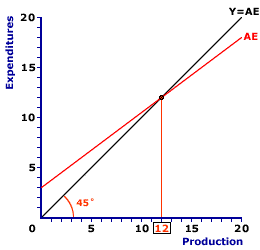An inflationary gap arises in the Keynesian model of the macroeconomy when the equilibrium level of aggregate production exceeds what could be produced at full employment. This represents the condition that arises when the economy is in a business-cycle expansion. Graphically, an inflationary gap is illustrated by the Keynesian cross if equilibrium aggregate production is to the right of full-employment aggregate production.Keynesian Cross Equilibrium
| Equilibrium |  |
The exhibit to the right is a graphical representation of the basic Keynesian model, commonly termed the Keynesian cross. The "cross" term refers to the intersection between two lines, the red AE line and the black Y=AE line.The vertical axis measures expenditures, specifically aggregate expenditures. The horizontal axis measures production, specifically aggregate production or gross domestic product. This exhibit indicates activity in the macroeconomic product markets, or the aggregate product market.
The intersection of the 45-degree line and AE line, which is $12 trillion in this exhibit, is equilibrium. At $12 trillion the aggregate expenditures on production is equal to aggregate production. All four sectors are able to purchase all of the output they want and all output produced is purchased by one of the four sectors. There is neither a surplus nor a shortage of aggregate production.
But does this level of aggregate production achieve full employment?
Full Employment
| Full Employment | 
|
An important bit of analysis undertaken using the Keynesian model is the relation between equilibrium and full employment. Should equilibrium aggregate production not match the level of aggregate production generated at full employment, two gaps can arise--inflationary gap and recessionary gap.While we know the equilibrium level of aggregate production from the Keynesian cross analysis above, we also need to know the full-employment level of aggregate production. The relation between the two indicates which of the gaps, if either, might exist.
To reveal the full-employment level of aggregate production click the [Full Employment] button in the exhibit to the right. In this particular example, full employment results with $9 trillion of aggregate production, which is less than the $12 trillion equilibrium level of aggregate production.
The relation between equilibrium and full-employment aggregate production means the economy has an inflationary gap. To highlight the inflationary gap in this exhibit, click the [Inflationary gap] button. The resulting inflationary gap is $3 trillion of aggregate production. In other words, aggregate production needs to decrease by $3 trillion to eliminate this gap.
This is termed an inflationary gap because it arises during a business-cycle expansion and creates a situation in which inflationary pressure arises in which inflation is the more pressing problem facing the macroeconomy.
Note that this analysis indicates that the $12 trillion equilibrium can be at a level of aggregate production that is greater than full employment. And because $12 trillion is EQUILIBRIUM it persists once reached. There is no mechanism within the Keynesian model that automatically moves aggregate production to the full employment level.
As such, an outside force must intervene to achieve full employment. The recommended Keynesian remedy is stabilization policies, especially fiscal policy. In particular, an inflationary gap is closed through the use of contractionary fiscal policy.
Contractionary Fiscal Policy
Contractionary fiscal policy is a decrease in government spending and/or an increase in taxes designed to avoid or correct the inflationary problems associated with a business-cycle expansion.Either action causes a decrease or downward shift of the aggregate expenditures line. If the correct vertical shift is achieved, then the Keynesian model can achieve equilibrium at the $9 trillion full-employment level of aggregate production. Such a result would close the inflationary gap and reduce the rate of inflation.
Recessionary Gap
An inflationary gap is one of two alternatives that can arise if equilibrium aggregate production does not match full-employment aggregate production. The other is a recessionary gap. A recessionary gap results if equilibrium production is less than full-employment production. This is the sort of gap that tends to occur during a business-cycle contraction or recession in which unemployment is the more pressing problem facing the macroeconomy.INFLATIONARY GAP, KEYNESIAN MODEL, AmosWEB Encyclonomic WEB*pedia, http://www.AmosWEB.com, AmosWEB LLC, 2000-2025. [Accessed: July 18, 2025].


